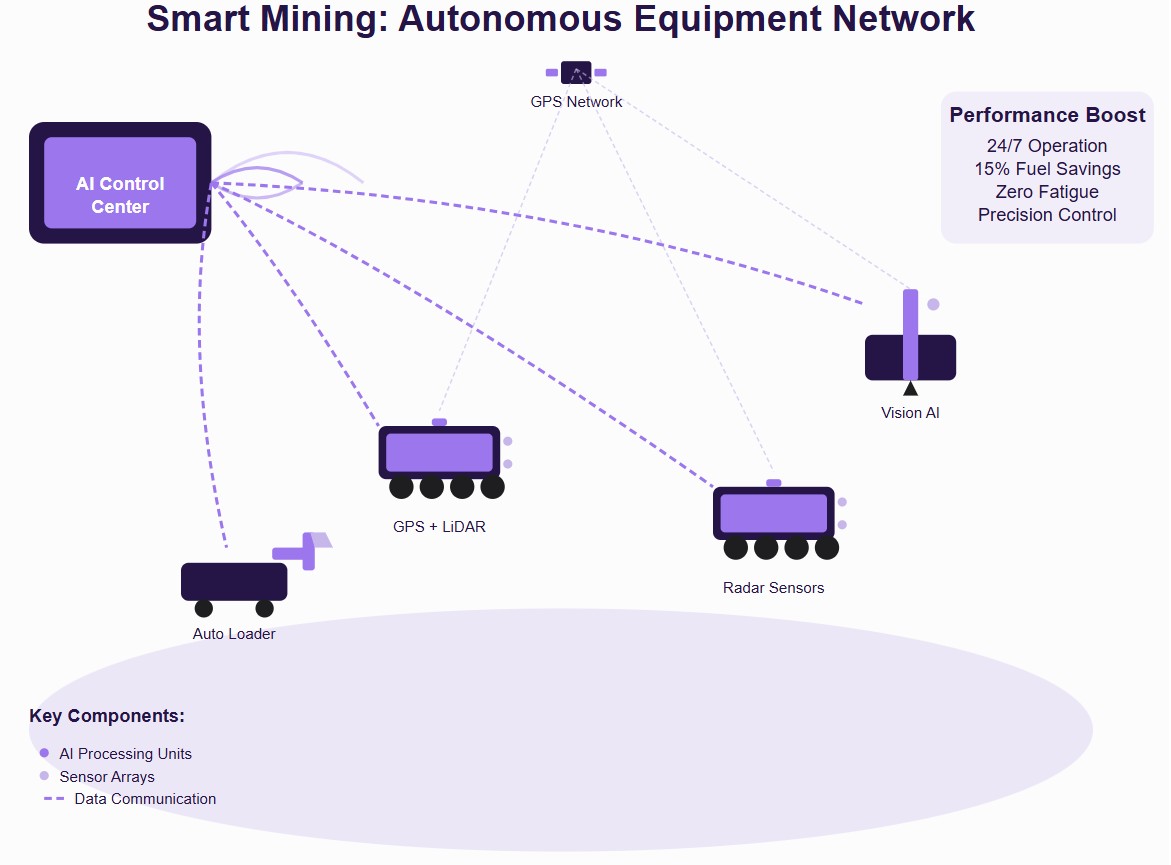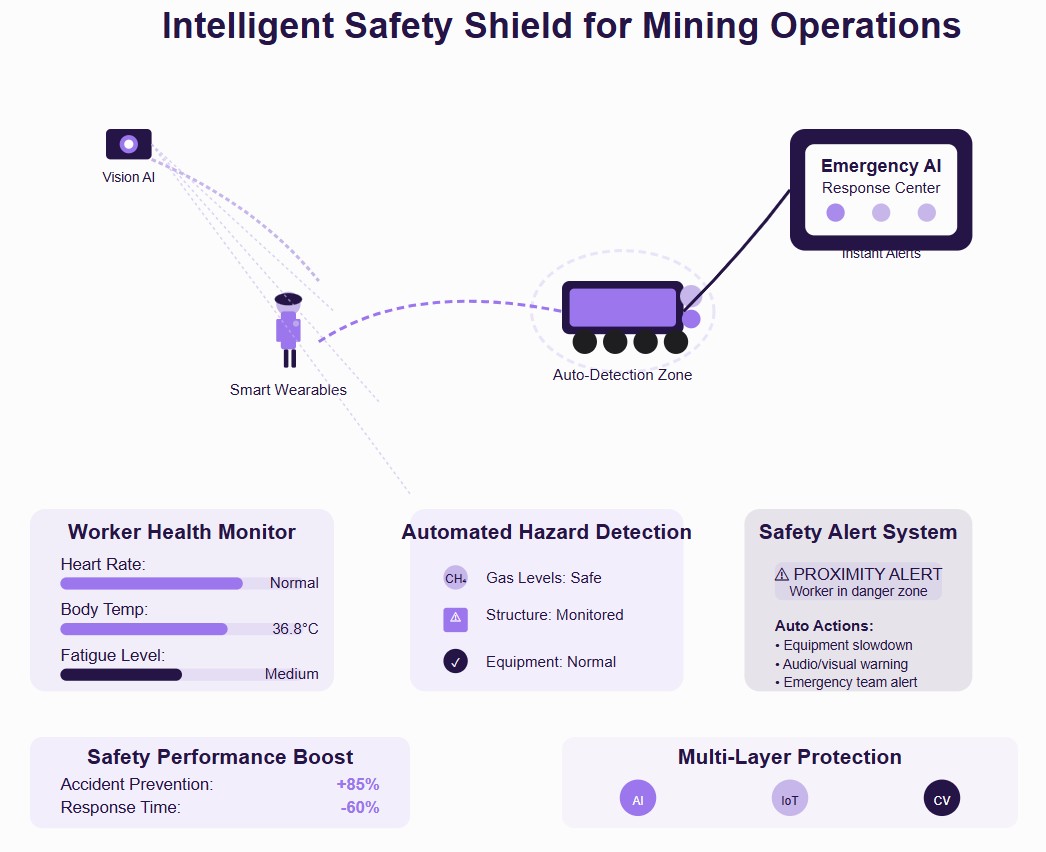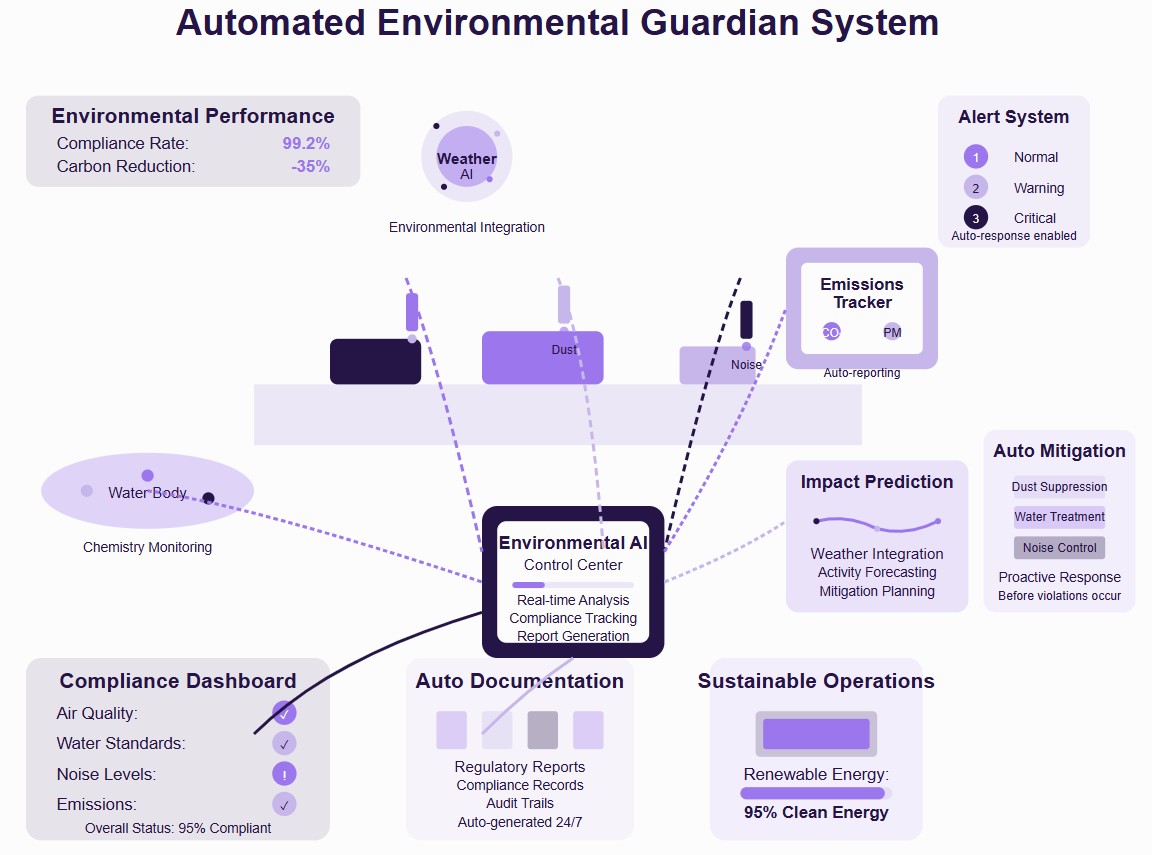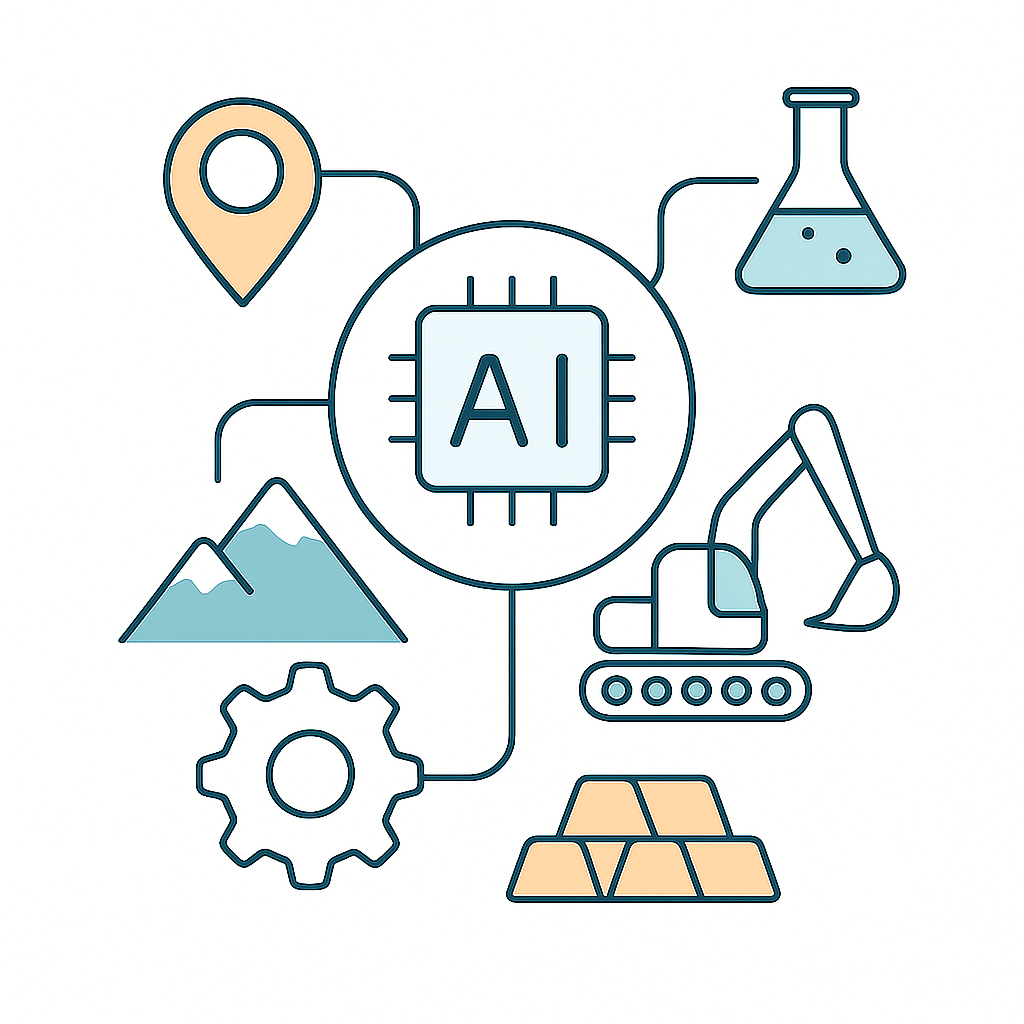Thermal-imaging drones can now detect ore veins buried deep beneath the earth - something unimaginable just a decade ago. As mining grows more complex and competitive, companies are turning to intelligent systems to gain an edge.
Understanding how AI can boost mining projects efficiency is key to unlocking faster decision-making, safer operations, and smarter resource use across every phase of the mining lifecycle.
In this article, we will explore:
- Turn mining operations into high-performance machines using AI
- Equip your team with the AI tools driving real mining success
- Match the right AI approach to your mine’s terrain and targets
7 Proven Ways AI Transforms Mining Operations Into High-Performance Powerhouses
The mining industry is experiencing a revolutionary transformation where AI isn't just changing operations - it's redefining what's possible. Companies implementing AI strategies are achieving productivity increases of up to 20% while dramatically reducing costs and improving safety.
Here's how leading mining operations are leveraging AI to gain competitive advantages.
1. Deploy Autonomous Equipment Systems
Autonomous equipment represents the backbone of modern smart mining, where machines work tirelessly without human limitations while maintaining superior precision and safety.
Key Implementation Strategies:
- Install autonomous haulage systems (AHS) with GPS, radar, and LiDAR technology for safe navigation in complex mining environments
- Retrofit existing truck fleets with plug-and-play autonomous kits rather than purchasing new vehicles
- Deploy computer vision-powered drilling rigs that optimize patterns and adjust for geological variations
- Implement robotic material handling for loading and transporting in hazardous areas
Success Story: Rio Tinto's 130+ autonomous trucks achieve 15% better fuel efficiency compared to manual operations.

2. Implement Predictive Maintenance Programs
Predictive maintenance transforms "fix when broken" approaches into sophisticated prevention strategies that keep equipment running while reducing unexpected downtime.
Essential Components:
- Install IoT sensors for vibration, temperature, and pressure monitoring on critical equipment
- Deploy machine learning algorithms that analyze data patterns to predict failures weeks in advance
- Create digital twins for virtual equipment health monitoring and testing maintenance scenarios
- Integrate with maintenance systems for automated scheduling and parts management
Proven Results: Votorantim Cimentos achieved $5.5 million in savings across six sites by preventing unplanned failures.
3. Optimize Operations with Real-Time AI Analytics
Real-time optimization creates intelligent systems that make thousands of micro-adjustments to maximize efficiency across interconnected mining operations.
Core Strategies:
- Install comprehensive sensor networks capturing equipment performance and environmental data
- Deploy AI algorithms for instant processing and optimization recommendations
- Integrate with ERP and MES systems to enhance existing workflows
- Train operators to respond effectively to AI-generated insights
Industry Example: BHP's Escondida mine uses Microsoft Azure AI for real-time concentrator optimization and grade recovery improvements.
4. Enhance Exploration with AI-Driven Discovery
AI-powered exploration transforms mineral discovery from costly guesswork into precision-targeted endeavors that dramatically improve success rates.
Advanced Techniques:
- Use machine learning to analyze geological data and satellite imagery for mineral indicators
- Process historical records with AI to identify overlooked patterns and opportunities
- Implement geospatial intelligence, combining multiple data sources for prospectivity models
- Create predictive models for more accurate resource estimation and feasibility
Innovation Spotlight: KoBold Metals uses AI for rare earth discovery, achieving dramatically improved success rates versus traditional methods.
5. Strengthen Safety Through Intelligent Monitoring
AI-powered safety systems create protective layers that monitor hazards and worker well-being faster than human observation alone.
Safety Enhancement Methods:
- Install proximity detection systems that automatically alert when workers enter danger zones
- Deploy wearable sensors monitoring heart rate, temperature, and fatigue levels
- Implement computer vision for automated hazard detection and compliance monitoring
- Create emergency response systems for instant alerts and coordinated rescue efforts
Safety Innovation: Anglo American uses computer vision AI to automatically detect safety hazards missed during manual inspections.

6. Streamline Supply Chain and Logistics
AI-driven supply chain optimization transforms complex logistics into highly coordinated systems that predict needs and prevent disruptions.
Strategic Improvements:
- Deploy demand forecasting algorithms, analyzing production schedules and maintenance needs
- Implement predictive analytics for supply chain risk management and disruption prevention
- Create automated procurement monitoring usage patterns, and maintain optimal inventory
- Optimize transportation considering route efficiency, load optimization, and delivery timing, just like AI project management software for sales improves lead flow and conversion tracking
Results: Major operators report 15-25% inventory cost reductions while improving material availability.
7. Accelerate Environmental Compliance
Automated environmental monitoring ensures regulatory compliance while proactively managing environmental impact through continuous monitoring.
Management Automation:
- Install automated monitoring systems tracking air quality, water chemistry, and noise levels
- Implement emissions tracking with automatic compliance report generation
- Deploy predictive impact models, forecasting effects, and recommending mitigation strategies
- Create documentation systems, maintaining compliance records, and regulatory reports
Sustainability Leadership: Leading companies achieve 95% renewable energy utilization while maintaining strict environmental compliance.

As AI continues to evolve, mining leaders who act early will shape the next era of operational dominance and resilience.
Power Your Mine with the Right AI Tool: What Top Teams Are Using
The mining tech stack is evolving fast. Whether you're looking to enhance exploration, reduce downtime, or automate safety, AI software solutions now offer mining-specific capabilities that deliver measurable impact.
Below is a curated list of top AI tools used by mining leaders worldwide.
These tools aren’t just plug-ins - they’re strategic enablers that drive efficiency across your mining value chain. Choosing the right one depends on your operational goals, existing systems, and digital maturity, just like agency project management tools adapt to different campaign sizes.
Pro Tip: Start with a focused use case, like maintenance or safety, before scaling AI tools across multiple operations.
Tailoring AI Solutions to Your Mine's Unique Environment and Commodity
Every mine operates differently, and cookie-cutter AI solutions simply don't deliver optimal results. The most successful AI implementations are specifically designed around your operation's unique characteristics - from geological conditions to commodity types to environmental challenges.
Here's how leading mining companies customize AI strategies for maximum impact.

Open-Pit vs. Underground Mining: AI Strategy Fundamentals
Mining environment fundamentally shapes AI implementation success. Surface and underground operations require completely different technological approaches and strategic considerations.
Open-Pit Mining AI Applications
Open-pit operations offer ideal conditions for comprehensive AI deployment due to better connectivity, equipment accessibility, and environmental predictability.
Key AI Advantages:
- Autonomous haulage systems operate more effectively with clear sight lines and GPS connectivity
- Real-time fleet optimization across visible terrain with minimal signal interference
- Comprehensive drone surveillance for safety monitoring and progress tracking
- Weather-responsive operations using AI to adjust activities based on conditions
Technology Focus: Large-scale autonomous equipment, satellite-based monitoring, and integrated fleet management systems work exceptionally well in open-pit environments.
Underground Mining AI Customization
Underground operations require specialized AI solutions designed for challenging connectivity, confined spaces, and unique safety requirements.
Critical Considerations:
- Limited connectivity demands edge computing and offline-capable AI systems
- Proximity detection becomes paramount with confined spaces and limited visibility
- Air quality monitoring requires continuous AI-powered environmental systems
- Emergency response automation must account for evacuation complexity
Technology Adaptations: Focus on mesh networks, wearable safety devices, and AI systems that function reliably with intermittent connectivity.
Commodity-Specific AI Optimization Strategies
Different minerals demand unique AI approaches. Coal, rare earths, lithium, and copper operations each present distinct challenges that require specialized artificial intelligence solutions.
Coal Mining AI Applications
Coal operations face unique environmental and safety challenges that require specialized AI approaches focused on methane detection, dust control, and regulatory compliance.
Specialized AI Systems:
- Methane monitoring algorithms that predict dangerous gas accumulation patterns
- Dust suppression optimization using weather data and extraction patterns
- Longwall automation with AI-guided cutting sequences and roof support
- Environmental compliance tracking for emissions and water management
Rare Earth Element Extraction
Rare earth mining involves complex processing requirements where AI optimization can significantly improve recovery rates and reduce environmental impact.
AI Applications:
- Geochemical analysis algorithms for identifying optimal extraction zones
- Processing optimization for complex separation and purification processes
- Quality control automation ensures consistent rare earth purity levels
- Waste stream management, minimizing environmental impact through AI-guided processing
Lithium Mining Operations
Lithium extraction demands precision in brine management and evaporation processes, where AI provides critical optimization capabilities.
Key AI Benefits:
- Brine concentration monitoring using real-time chemical analysis and weather data
- Evaporation pond optimization, maximizing lithium yield through environmental modeling
- Water management systems balance extraction needs with environmental protection
- Market-responsive production adjusts output based on demand forecasting
Copper Mining Optimization
Copper operations benefit from AI-driven ore grade optimization and processing efficiency improvements that directly impact profitability.
Strategic AI Applications:
- Ore blending algorithms optimizing grade consistency for processing efficiency
- Flotation process optimization using real-time chemistry monitoring
- Concentrate quality control, ensuring consistent copper content and minimal impurities
- Smelting optimization reduces energy consumption while maintaining output quality
Environmental Factors Affecting AI Performance
Location and climate conditions significantly impact AI system effectiveness. Temperature extremes, humidity levels, and geological characteristics require careful consideration in AI deployment strategies.
Climate and Weather Impact
Environmental conditions significantly influence AI system performance, requiring customized approaches based on your mine's location and climate patterns.
Desert Mining Operations:
- Temperature extremes affect sensor accuracy and equipment performance
- Dust and sand infiltration require ruggedized AI hardware and frequent calibration
- Solar radiation impact on optical sensors needs compensation algorithms
Arctic and Cold Climate Mining:
- Battery performance degradation in autonomous equipment requires AI-managed power systems
- Ice formation on sensors demands automated cleaning and heating systems
- Shortened daylight hours necessitate AI lighting optimization for safety
Tropical and High-Humidity Environments:
- Corrosion acceleration requires AI-powered predictive maintenance with adjusted algorithms
- Heavy rainfall impact on operations needs weather-responsive AI scheduling
- Vegetation growth affecting sensor placement requires regular AI system recalibration
Geological Complexity Considerations
Geological characteristics directly impact AI effectiveness, requiring customized algorithms for different rock types and formations.
Hard Rock Mining:
- Vibration analysis requires specialized algorithms for granite and similar formations
- Drill bit optimization using AI to adjust parameters for rock hardness variations
- Blast pattern optimization considering rock fracture characteristics
Soft Rock and Sedimentary Formations:
- Stability monitoring using AI to predict cave-ins and structural failures
- Water infiltration prediction managing dewatering systems automatically
- Ground support optimization adjusting techniques based on formation stability
Strategic customization unlocks the full potential of AI, driving smarter decisions and sustainable gains across diverse mining setups.
Reimagine Mining Workflows With Real-Time Intelligence
Mining operations are evolving fast, and those equipped with intelligent systems are setting the pace. From precision-driven exploration to predictive maintenance, real-time data is powering safer, faster, and more cost-efficient outcomes across the entire mining lifecycle.
By aligning the right tools with your site’s unique conditions, you position your team to lead with confidence. Smarter workflows start with smarter decisions - driven by real-time intelligence.


.png)
_light%201.png)





